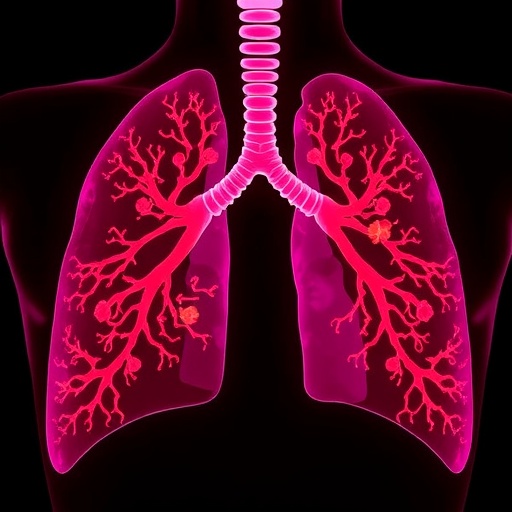In a groundbreaking study, researchers Kannan and Mohan have unveiled an innovative therapeutic approach for idiopathic pulmonary fibrosis (IPF), a progressive and often fatal lung disease characterized by scarring of lung tissue. The study delves into the intertwined roles of the mechanistic target of rapamycin complex 1 (mTORC1) and transforming growth factor-beta 1 (TGFB1) signaling pathways, suggesting that inhibiting these pathways could pave the way for new treatment protocols. Their work, blending computational modeling with experimental data, introduces a potent combination therapy involving the natural compounds Bergapten and Esculetin, offering fresh hope in the fight against this debilitating condition.
Idiopathic pulmonary fibrosis remains one of the most enigmatic diseases in pulmonology, with its causative factors remaining poorly understood and treatment options limited primarily to symptom management rather than outright cures. The pathogenesis of IPF is believed to be influenced by multiple pathways, among which mTORC1 and TGFB1 play critical roles in fibrosis development. mTORC1 serves as a central regulator of cellular growth and metabolism, while TGFB1 is a key driver of fibroblast activation and collagen deposition. Consequently, targeting these pathways may help halt the progression of fibrosis and enhance lung function.
The study conducted by Kannan and Mohan utilized a meticulous combination of computational and experimental methodologies. Through advanced modeling techniques, the researchers simulated the effects of various compounds on mTORC1 and TGFB1 signaling, ultimately identifying the synergistic potential of Bergapten and Esculetin. Bergapten, derived from the plant species Archangelica, and Esculetin, a naturally occurring coumarin, have both demonstrated anti-inflammatory and antioxidant properties, suggesting they could work together to modulate the fibrotic response in lung tissue.
In their experimental phase, the researchers treated lung fibroblast cells—cell types integral to the formation of connective tissue—with varying concentrations of the Bergapten-Esculetin combination. Remarkably, the results showed a significant reduction in fibroblast proliferation and collagen production, pinpointing the targeted effectiveness of this novel combination therapy. This provides essential evidence in favor of a structured protocol aimed at restricting the fibrogenic effects driven by pathological activation of the mTORC1 and TGFB1 signaling networks.
Furthermore, the study highlights the need for a more integrated approach to drug development for IPF. Traditional models often evaluate the efficacy of a single drug; however, the exploratory framework utilized by Kannan and Mohan underlines the effectiveness of dual-action therapies. This type of innovative thinking is essential, especially given the complexities of fibrotic diseases wherein multiple pathways can contribute simultaneously to pathology. The potential for combining compounds to enhance treatment efficacy could revolutionize how conditions like IPF are approached in clinical settings.
Moreover, the findings prompt a reevaluation of current therapeutic strategies for IPF, which primarily rely on antifibrotic agents like pirfenidone and nintedanib. While these agents slow disease progression, they do not cure the condition. The introduction of a natural compound combination, particularly one with validated dual-targeting capabilities such as Bergapten and Esculetin, may represent a transformative step toward more effective treatment protocols.
Given the severity and complexity associated with IPF, additional research is vital. Future studies should focus on optimizing the dosing regimens of Bergapten and Esculetin, assessing the long-term outcomes of this combination therapy, and exploring its effects in vivo. Animal models that mimic the pathological features of IPF will be crucial for understanding how this therapeutic approach may behave in a living organism, ultimately leading to human trials aimed at confirming its safety and efficacy.
In summary, the integration of computational and experimental methodologies reflects a promising future for therapeutic innovation within the arena of pulmonary disease. The implications of Kannan and Mohan’s research extend far beyond their specific findings on Bergapten and Esculetin; they signal a potential paradigm shift in how we approach complex diseases like IPF. With heightened collaboration between computational biology and experimental medicine, the route to finding effective and comprehensive treatments could become significantly more attainable.
As the scientific community begins to absorb these findings, the hope is that a deeper understanding of the underlying mechanisms of IPF will lead to breakthroughs that not only improve patient outcomes but also redefine therapeutic standards in treating pulmonary fibrosis. The advancement signifies a crucial step towards enhancing the quality of life for individuals afflicted by this challenging disease, ensuring that research not only remains a pursuit of knowledge but translates into tangible benefits for patients worldwide.
In conclusion, this novel approach exemplifies the importance of interdisciplinary collaboration in tackling complex medical challenges. The convergence of computational insights with laboratory research showcases the potential of innovative therapeutic strategies to unlock answers to some of the most pressing questions in medicine today. As we stand on the brink of a new era in pulmonary medicine, the implications of this study could resonate for years to come, inspiring further exploration into combination therapies for other multifactorial diseases.
Subject of Research: Idiopathic Pulmonary Fibrosis
Article Title: Targeting mTORC1/TGFB1 signaling with a novel Bergapten-Esculetin combination: a computational and experimental approach in idiopathic pulmonary fibrosis.
Article References: Kannan, K., Mohan, S. Targeting mTORC1/TGFB1 signaling with a novel Bergapten-Esculetin combination: a computational and experimental approach in idiopathic pulmonary fibrosis. Mol Divers (2025). https://doi.org/10.1007/s11030-025-11401-5
Image Credits: AI Generated
DOI: https://doi.org/10.1007/s11030-025-11401-5
Keywords: Idiopathic Pulmonary Fibrosis, mTORC1, TGFB1, Bergapten, Esculetin, Combination Therapy, Fibrosis, Therapeutic Approach.
Tags: combination therapy for idiopathic pulmonary fibrosiscomputational modeling in medical researchenhancing lung function in IPFfibrosis treatment advancementsidiopathic pulmonary fibrosis researchinnovative approaches to IPF therapyKannan and Mohan study on fibrosislung tissue scarring mechanismsmTORC1 signaling pathway in pulmonary fibrosisnatural compounds in fibrosis treatmentTGFB1 role in lung diseasetherapeutic targets in pulmonary diseases





